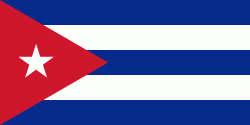Frank País Airport (Frank País International Airport)
Frank País Airport (Aeropuerto Frank País) is an airport serving Holguín, a city in the Cuban province of Holguín. It bears the name of Cuban revolutionary Frank País. The airport was built in 1962 initially only for military purposes before civilian air operations began in 1966. It consists of a domestic and an international terminal, which was built in 1996 and expanded in 2007.
The aviation history of Holguín originates in a makeshift runway built near the Hill of the Cross (Loma de la Cruz) in the city. Domingo Rosillo landed on this airstrip in 1914, one year after becoming the first pilot to fly between Key West and Havana. The first official airport serving Holguín was inaugurated on 30 October 1930. On this day, the airport served as one of several stops on the first airmail route in Cuba, between Havana and Santiago de Cuba. The airport was located in the neighbourhood of Peralta and named after mambí General Julio Grave de Peralta. However, because there was often dense fog at the airport, it closed a few years afterward; and operations moved to another site close to the location of the current airport.
In 1962, a military airbase was established on the outskirts of the city. Civilian air operations shifted to an area within the base on 10 November 1966, thus establishing Frank País Airport. As the tourism sector in Guardalavaca grew during the early 1990s, there was a need for a new international terminal, which was constructed in 1996 by Canadian infrastructure company Intelcan Technosystems. In 2007, the capacity of the terminal was doubled to 1,200 passengers per hour through a 1,300 m2 expansion, which took one year to complete. Carried out to reduce congestion in the terminal during peak season, the expansion included additional customs facilities and a new VIP lounge. The inauguration of the expanded facilities was presided over by politician and then future president of Cuba, Miguel Díaz-Canel.
On 25 March 2020, it was announced that international flights from the airport were ceasing because of the coronavirus shutdown. Flights began again on 3 November 2020, with three flights.
The aviation history of Holguín originates in a makeshift runway built near the Hill of the Cross (Loma de la Cruz) in the city. Domingo Rosillo landed on this airstrip in 1914, one year after becoming the first pilot to fly between Key West and Havana. The first official airport serving Holguín was inaugurated on 30 October 1930. On this day, the airport served as one of several stops on the first airmail route in Cuba, between Havana and Santiago de Cuba. The airport was located in the neighbourhood of Peralta and named after mambí General Julio Grave de Peralta. However, because there was often dense fog at the airport, it closed a few years afterward; and operations moved to another site close to the location of the current airport.
In 1962, a military airbase was established on the outskirts of the city. Civilian air operations shifted to an area within the base on 10 November 1966, thus establishing Frank País Airport. As the tourism sector in Guardalavaca grew during the early 1990s, there was a need for a new international terminal, which was constructed in 1996 by Canadian infrastructure company Intelcan Technosystems. In 2007, the capacity of the terminal was doubled to 1,200 passengers per hour through a 1,300 m2 expansion, which took one year to complete. Carried out to reduce congestion in the terminal during peak season, the expansion included additional customs facilities and a new VIP lounge. The inauguration of the expanded facilities was presided over by politician and then future president of Cuba, Miguel Díaz-Canel.
On 25 March 2020, it was announced that international flights from the airport were ceasing because of the coronavirus shutdown. Flights began again on 3 November 2020, with three flights.
| IATA Code | HOG | ICAO Code | MUHG | FAA Code | |
|---|---|---|---|---|---|
| Telephone | +53 24 425271, 423934 | Fax | +53 24 468087 | ||
| Home page |
Map - Frank País Airport (Frank País International Airport)
Map
Country - Cuba
 |
 |
| Flag of Cuba | |
The territory that is now Cuba was inhabited by the Ciboney people from the 4th millennium BC with the Guanahatabey and Taíno peoples until Spanish colonization in the 15th century. From the 15th century, it was a colony of Spain, and slavery was abolished in 1886, remaining a Spanish colony until the Spanish–American War of 1898, when Cuba was occupied by the United States and gained independence in 1902. In 1940, Cuba implemented a new constitution, but mounting political unrest culminated in a coup in 1952 and the subsequent dictatorship of Fulgencio Batista, which was later overthrown in January 1959 by the 26th of July Movement during the Cuban Revolution, which afterwards established communist rule under the leadership of Fidel Castro. The country was a point of contention during the Cold War between the Soviet Union and the United States, and a nuclear war nearly broke out during the Cuban Missile Crisis of 1962. Following the collapse of the Soviet Union, Cuba faced a severe economic downturn in the 1990s, known as the Special Period. In 2008, Fidel Castro resigned after 49 years of leadership of Cuba and was replaced by his brother Raúl Castro.
Currency / Language
| ISO | Currency | Symbol | Significant figures |
|---|---|---|---|
| CUC | Cuban convertible peso | $ | 2 |
| CUP | Cuban peso | $ | 2 |
| ISO | Language |
|---|---|
| ES | Spanish language |















